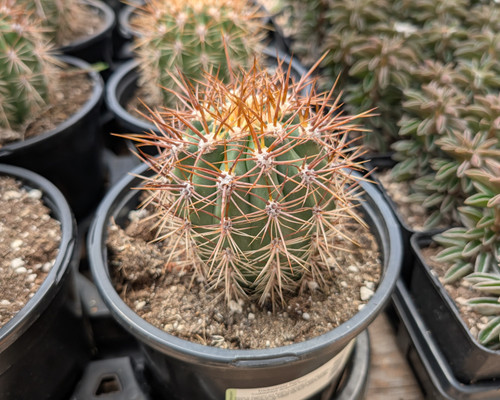Pot Size: 1 Gal
Accepted Scientific Name:
Echinocactus grusonii
Origin and Habitat:
Echinocactus grusonii, commonly known as the Golden Barrel Cactus, is native to central Mexico, particularly the states of Hidalgo and Querétaro. It grows naturally on volcanic rock slopes, in arid and semi-arid environments with high sun exposure, well-draining soils, and sparse vegetation. In its natural habitat, rainfall is infrequent, and temperatures fluctuate widely between day and night, creating conditions where the species thrives. Unfortunately, wild populations are now endangered due to habitat destruction and over-collection, making cultivated specimens essential for conservation and horticultural appreciation.
Description:
The Golden Barrel Cactus is a striking globular species that can grow up to 36 inches (90 cm) in diameter and eventually form clusters with age. Its ribbed, spherical body is covered with dense golden-yellow spines that give it a radiant glow in sunlight. Flowers appear at maturity, typically after 15 years or more, forming a ring at the crown. These funnel-shaped flowers are bright yellow and can reach 2 inches (5 cm) in diameter, adding a vibrant contrast to the spiny structure.
Cultivation:
Zone: Suitable for USDA Zones 9–11
Temperature: Optimal range is 10–30 °C, tolerates brief drops to 5 °C if dry
Growth Rate: Slow, requiring many years to reach large sizes
Soil: Well-draining mix with pumice instead of sand for aeration and moisture control
Watering: Infrequent but deep watering during the growing season; allow soil to dry fully between waterings; keep nearly dry in winter
Fertilizing: Apply a balanced cactus fertilizer every 2–3 weeks during active growth in spring and summer
Light: Requires full sun outdoors or very bright light indoors; insufficient light reduces spine density and golden color
Pests and Diseases: Susceptible to mealybugs, scale insects, and root rot if overwatered; ensure proper airflow and soil drainage to prevent fungal issues
Propagation:
Propagation is most commonly achieved by seed, though mature plants may form offsets that can be separated and rooted. Germination from seed is slow but reliable when provided with warmth, light, and a well-draining medium.







